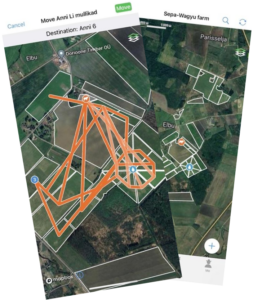
Regenerative agriculture
At the heart of regenerative agriculture is soil, which is cared for as a living organism. Essential components of this organism include both above-ground plants and soil organisms below the surface, as well as the soil structure formed with their aid, allowing air and water to move freely. Plant roots release exudates into their surrounding environment, largely sugars synthesized by the leaves during photosynthesis. These sugars attract soil microorganisms, which consume them and, in return, provide the plant with necessary minerals and other compounds that enhance its immunity.
To establish soil functioning in a way that nurtures plants, retains water more effectively, and forms a good aerated structure, regenerative agriculture proposes five principles of soil health.
Animals
Wherever possible, agricultural animals and their manure should be integrated into the cropping system. If we confine them to some closed space, a host of problems arise that can be avoided by placing animals where nature intended them to be - out grazing on grass.
Limitation of disturbances
Any soil disturbance, excessive movement, and the use of synthetic substances should be minimized. Such activities are rarely found in nature's functioning without human intervention.
Diversity.
Integrating mixed production and cultivation, diversifying crop and livestock farming, and incorporating natural area systems support the natural processes necessary for agricultural production.
Keeping the soil covered with vegetation.
The soil should be covered most of the time. Otherwise, nature will plant its own vegetation, which we typically don't prefer, and we call them weeds.
Living roots
``Plants nourish soil life with their sugar-rich carbon compounds. They can give away up to 40% of their photosynthesis products. Soil life, in turn, enhances plants' defense mechanisms against pathogens and diseases and provides them with necessary nutrients that would otherwise be inaccessible to the plant.``
Portsjonkarjatamine võib tunduda väga uuendusmeelne, kuid tegelikult on see väga vana põllumajanduslik praktika. Eestis hakati seda rakendama juba 1960. aastatel ja esimesed viited pärinevad juba 1700. aastast, kui üks Šoti teadlane sellest rääkis. Kahjuks on see siiski üsna vähe levinud. Tavaliselt kasutatakse ikkagi püsikarjatamist. Portsjonkarjatamine nõuab kindlasti katsetamist oma farmi tingimustes. Miks seda peaks tegema? Kindlasti selleks, et säilitada taimestik ja muuta see mitmekesisemaks. Näiteks kui loom sööb ära taime ülemise osa poole, jätkavad juured siiski edukalt kasvamist. Seega ei toimu mingit pausi. Kui loom sööb ära üle poole, umbes 10% kõrgusest, siis pooled juurtest peatavad oma kasvu. Kui taimestik on täiesti söödud (umbes 1 cm kõrgune), siis juurte kasv peatub väga pikaks ajaks. Lõpuks taastub see siiski, kuid selleks on vaja umbes 45-50 päeva puhkust. Karjakasvatajatel on tugev ettekujutus, et rohi peab olema 10-15 cm kõrgune. Praktika näitab aga, et taimestik peaks olema palju kõrgem, vähemalt mingis faasis.
“Invested time and knowledge to create perfection“
Permanent grazing
Advantages:
- Costs are low (watering systems, cattle yards)
- A herdsman does not have to deal with animals on a daily basis
Disadvantages:
- Erosion – animals have a habit of gathering in one place during the rest period, and this means that the manure is in the same place. Parasites and diseases arise from it.
- Low feed consumption – the animals only eat the plants they like and the farmer has to mow the pasture afterwards. So the cost is already added. Animals eat the lowest and sweetest part and the plants have no time to recover. It does not have a bad effect on the animal, but it affects the plant. Overgrazing can cause the destruction of some plants. Weeds and plants also start to spread, which start to grow in empty places or where animals sleep.
- Shorter grazing season – if the pastures are overgrazed and they don’t have enough rest time and there is a drought, then nothing will grow there after August. By grazing the portion, animals can be grazed until late autumn. Or until the snow falls.
- Greater need for hay and silage for the winter feeding period.
Portion grazing
Advantages:
- Weeds are under control
- Greater plant diversity
- Erosion and soil compaction can be prevented
- More even distribution of manure
- Less need for silage and hay
- Higher in milk-producing animals
- The animals are very easy to handle and are persistent gardeners – they are used to following people and do not need to be chased.
- Cost savings – less need to renew pastures. Old pastures do not need to be plowed up. The plant will regenerate itself and the plants that once grew there will also come back. Seed stock is generally present in old permanent grasslands. If the top layer of the soil becomes a suitable environment for these plants and the animals do not eat them again all the time, the species diversity will be restored. Also, the root system of plants becomes deeper and springier. This prevents the earth from being broken up by animals during the rainy season.
Disadvantages:
- Greater workload – must visit the animals daily.
- The cost of garden accessories and water systems – in the long term, it is still an investment and a one-time cost.
We use Pastusremap to manage and simplify portion grazing. It’s a premium US desktop and mobile app used by thousands of ranchers to simplify grazing management, make accurate predictions and get the most out of their land. It makes grazing planning easier by showing, for example, the rest period of the lands, the location of the animals, the number of animals, etc. Animal scales can also be entered there. It is possible to take pictures of pastures that have been grazed and pastures that are starting to be grazed. Pasture history and animal movements can be stored there, and reports can be extracted later.
